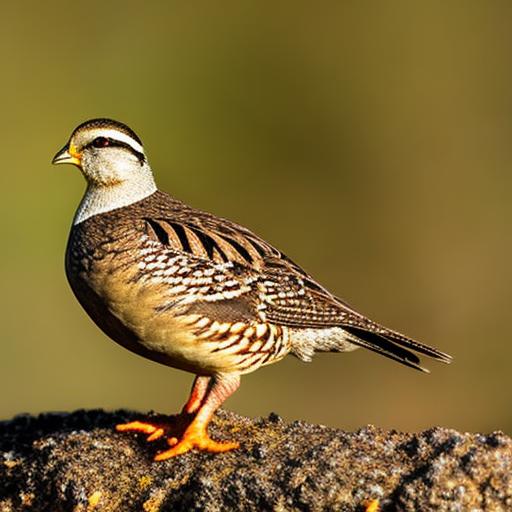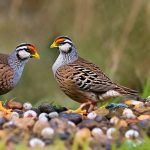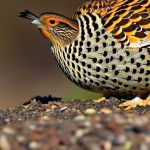Quails are small, ground-dwelling birds that are known for their elusive and skittish behavior. They are often found in grasslands, agricultural fields, and open woodlands. Quails are primarily active during the day and are known to forage for food in groups. They are omnivorous birds, feeding on a variety of seeds, insects, and small invertebrates. Quails are also known for their nesting behavior, often building their nests on the ground in hidden locations to protect their eggs and young from predators.
Understanding the behavior of quails is crucial when it comes to implementing effective control measures. By knowing their habits and preferences, it becomes easier to devise strategies that will deter them from causing damage to crops or property. Additionally, understanding their behavior can help in identifying the most effective methods for controlling their population and preventing future infestations.
Quails are known for their ability to adapt to different environments, making them a common nuisance for farmers and gardeners. They can cause damage to crops by feeding on seeds and young plants, as well as by scratching and pecking at the soil. Their presence can also attract other pests, such as rodents and insects, further exacerbating the problem. By understanding the behavior of quails, it becomes clear that effective control measures are necessary to prevent damage and protect crops and property.
Key Takeaways
- Quails are ground-dwelling birds that are attracted to open areas with low vegetation and easy access to food and water.
- Physical barriers such as fences, netting, and covers can effectively prevent quails from entering specific areas.
- Natural repellents like garlic, chili pepper, and predator urine can deter quails from foraging in gardens and crops.
- Creating a hostile environment by removing hiding spots and reducing food and water sources can discourage quails from frequenting an area.
- Scare tactics such as visual deterrents, noise makers, and predator decoys can startle and drive quails away from targeted areas.
- Removing attractants like spilled birdseed, fallen fruits, and standing water can help reduce quail activity in a given area.
- Seeking professional help from wildlife control experts can provide effective and humane solutions for managing quail behavior in urban and suburban environments.
Implementing physical barriers
One effective method for controlling quail populations is by implementing physical barriers. This can include the use of fencing, netting, or other structures that prevent quails from accessing certain areas. Fencing can be particularly effective in protecting crops and gardens from quail damage. By installing a sturdy fence around the perimeter of the area, quails can be prevented from entering and causing harm to plants and crops.
Netting can also be used to protect specific plants or areas from quail damage. By covering vulnerable plants with netting, quails are unable to access them, reducing the risk of damage. Additionally, netting can be used to protect fruit trees or berry bushes from quail feeding, ensuring a bountiful harvest.
Physical barriers are an effective and long-term solution for controlling quail populations. By preventing their access to vulnerable areas, damage to crops and property can be minimized. It is important to ensure that any physical barriers used are properly installed and maintained to ensure their effectiveness in deterring quails.
Using natural repellents
Another method for controlling quail populations is by using natural repellents. There are several natural substances that can be used to deter quails from specific areas. For example, the scent of predator urine or feces can be effective in deterring quails from entering an area. By strategically placing these natural repellents around vulnerable plants or crops, quails can be discouraged from causing damage.
Additionally, certain plants and herbs have natural repellent properties that can be used to deter quails. For example, planting marigolds or garlic around vulnerable plants can help repel quails due to their strong scent. These natural repellents not only deter quails but also add beauty and diversity to the garden or landscape.
Using natural repellents is a safe and environmentally friendly method for controlling quail populations. By harnessing the power of natural substances, it is possible to deter quails without causing harm to the birds or the environment. When using natural repellents, it is important to reapply them regularly to ensure their effectiveness in deterring quails.
Creating a hostile environment
Creating a hostile environment for quails is another effective method for controlling their populations. This can be achieved by modifying the landscape to make it less attractive to quails. For example, reducing the availability of food and water sources can discourage quails from frequenting an area. This can be done by removing bird feeders or water sources that attract quails.
Additionally, modifying the landscape by removing dense vegetation or ground cover can make an area less appealing to quails. By reducing hiding spots and nesting areas, quails are less likely to inhabit an area. This can be achieved by regularly mowing grassy areas or clearing brush and debris.
Creating a hostile environment for quails is a proactive approach to controlling their populations. By making an area less hospitable to quails, it is possible to reduce their presence and minimize damage to crops and property. It is important to regularly maintain the landscape to ensure that it remains unattractive to quails.
Employing scare tactics
Employing scare tactics is another effective method for controlling quail populations. There are several scare tactics that can be used to deter quails from specific areas. For example, visual deterrents such as scarecrows or reflective tape can be effective in deterring quails from entering an area. By creating movement or reflecting light, these visual deterrents can startle quails and discourage them from causing damage.
Auditory deterrents such as noise makers or predator calls can also be effective in scaring away quails. By creating loud noises or playing recordings of predator calls, quails can be deterred from inhabiting an area. Additionally, motion-activated devices that emit sound or light when triggered can startle quails and discourage them from causing damage.
Employing scare tactics is a non-lethal and humane method for controlling quail populations. By using visual and auditory deterrents, it is possible to deter quails without causing harm to the birds or the environment. It is important to regularly change the location or type of scare tactics used to prevent quails from becoming accustomed to them.
Removing attractants

Removing attractants is an important step in controlling quail populations. Quails are attracted to areas with an abundant food supply and suitable nesting sites. By removing these attractants, it is possible to discourage quails from frequenting an area. For example, removing spilled birdseed or pet food can reduce the availability of food sources for quails.
Additionally, removing dense vegetation or ground cover can eliminate potential nesting sites for quails. By clearing brush and debris, it is possible to reduce the attractiveness of an area to quails. It is also important to regularly maintain the landscape by mowing grassy areas and trimming shrubs to prevent the accumulation of attractants.
Removing attractants is a proactive approach to controlling quail populations. By eliminating food sources and nesting sites, it is possible to reduce the presence of quails and minimize damage to crops and property. It is important to regularly inspect the area for potential attractants and take steps to remove them promptly.
Seeking professional help
In some cases, controlling quail populations may require professional assistance. Pest control professionals have the knowledge and experience to effectively manage quail infestations using safe and humane methods. They can assess the situation and develop a customized plan for controlling quail populations based on the specific needs of the property.
Professional pest control services may include trapping and relocating quails to a more suitable habitat, as well as implementing long-term prevention strategies to deter future infestations. Additionally, pest control professionals can provide valuable advice on how to make the property less attractive to quails and prevent future damage.
Seeking professional help is a proactive approach to controlling quail populations and preventing damage to crops and property. Pest control professionals have the expertise and resources to effectively manage quail infestations while ensuring the safety of the birds and the environment. It is important to work with reputable pest control companies that prioritize humane and environmentally friendly methods for controlling quail populations.
In conclusion, understanding the behavior of quails is crucial when it comes to implementing effective control measures. By knowing their habits and preferences, it becomes easier to devise strategies that will deter them from causing damage to crops or property. Implementing physical barriers such as fencing or netting can effectively prevent quails from accessing certain areas, while using natural repellents such as predator urine or certain plants can deter them from causing harm. Creating a hostile environment by modifying the landscape and employing scare tactics are also effective methods for controlling quail populations. Additionally, removing attractants and seeking professional help when necessary are proactive approaches that can help prevent damage caused by quails while ensuring their safety and well-being.
Looking for ways to keep quails away from your chicken coop? Check out this informative article on PoultryWizard.com that provides helpful tips and strategies for protecting your coop from quails and other unwanted visitors. Learn more about creating a secure and quail-proof environment for your chickens.
FAQs
What are quails?
Quails are small, ground-dwelling birds that are found in various parts of the world. They are known for their distinctive calls and are often hunted for sport and food.
Why would someone want to keep quails away?
There are several reasons why someone might want to keep quails away. Quails can damage crops, gardens, and landscaping, and their droppings can create unsanitary conditions. Additionally, their presence can attract predators such as foxes and raccoons.
What are some methods for keeping quails away?
There are several methods for keeping quails away, including using physical barriers such as fences or netting, using scare tactics such as noise makers or predator decoys, and using repellents such as chemical sprays or natural deterrents like garlic or chili pepper.
Are there any legal restrictions on keeping quails away?
It is important to check local regulations and laws before attempting to keep quails away, as some methods may be prohibited or restricted in certain areas. Additionally, it is important to consider the potential impact on other wildlife and the environment when using deterrent methods.
Meet Walter, the feathered-friend fanatic of Florida! Nestled in the sunshine state, Walter struts through life with his feathered companions, clucking his way to happiness. With a coop that’s fancier than a five-star hotel, he’s the Don Juan of the chicken world. When he’s not teaching his hens to do the cha-cha, you’ll find him in a heated debate with his prized rooster, Sir Clucks-a-Lot. Walter’s poultry passion is no yolk; he’s the sunny-side-up guy you never knew you needed in your flock of friends!







